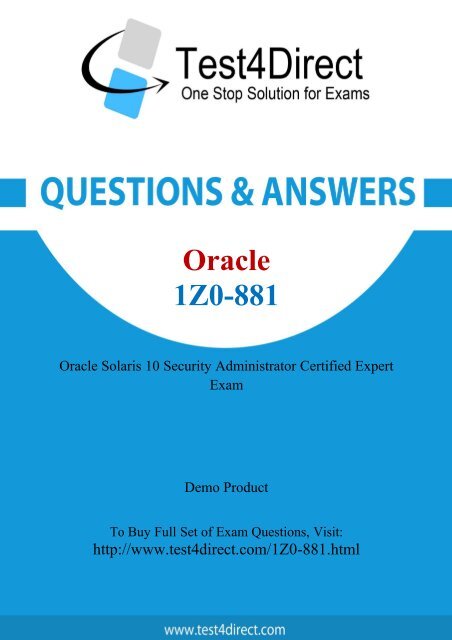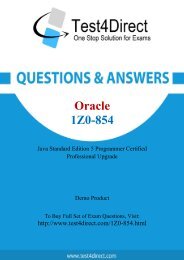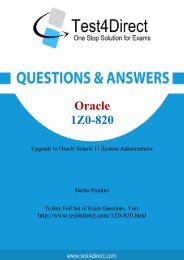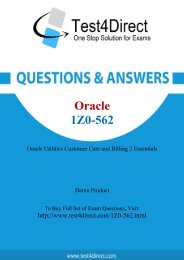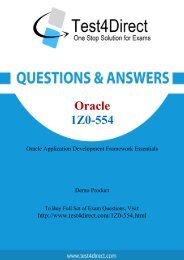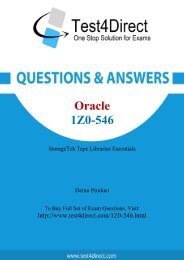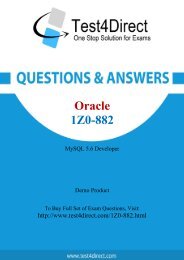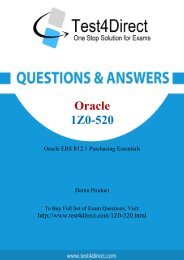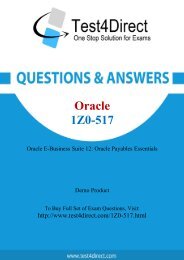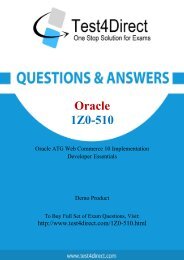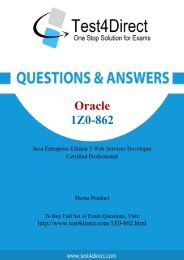Pass 1Z0-881 Exam Easily with BrainDumps
Test4Direct provides latest PDF questions of Oracle 1Z0-881 exam. You have an opportunity to pass the Oracle 1Z0-881 exam in one go. Test4Direct is most accurate source to prepare Oracle 1Z0-881 exam as your success will become site’s responsibility after purchasing 1Z0-881 exam product. There are also lots of discounts and promotion offers that you can avail. Let’s try a free demo http://www.test4direct.com/1Z0-881.html
Test4Direct provides latest PDF questions of Oracle 1Z0-881 exam. You have an opportunity to pass the Oracle 1Z0-881 exam in one go. Test4Direct is most accurate source to prepare Oracle 1Z0-881 exam as your success will become site’s responsibility after purchasing 1Z0-881 exam product. There are also lots of discounts and promotion offers that you can avail. Let’s try a free demo http://www.test4direct.com/1Z0-881.html
You also want an ePaper? Increase the reach of your titles
YUMPU automatically turns print PDFs into web optimized ePapers that Google loves.
Oracle<br />
<strong>1Z0</strong>-<strong>881</strong><br />
Oracle Solaris 10 Security Administrator Certified Expert<br />
<strong>Exam</strong><br />
Demo Product<br />
To Buy Full Set of <strong>Exam</strong> Questions, Visit:<br />
http://www.test4direct.com/<strong>1Z0</strong>-<strong>881</strong>.html
Question: 1<br />
A security administrator has a requirement to deploy the Solaris Security Toolkit onto all Solaris<br />
servers in the department. In this environment, there are a variety of platforms and operating system<br />
versions deployed. Onto which two platforms and operating system combinations can the Solaris<br />
Security Toolkit be deployed in a supported configuration? (Choose two.)<br />
A. X86, Solaris 2.4<br />
B. x64, Solaris 9<br />
C. x86, Solaris 10<br />
D. SPARC, Solaris 2.6<br />
E. SPARC. Solaris 8<br />
Question: 2<br />
Question: 3<br />
Question: 4<br />
Answer: C, E<br />
The company security policy now requires very detailed auditing of all actions. This includes<br />
capturing all executed commands together <strong>with</strong> their arguments and the environment variables.<br />
After activating auditing on all Solaris 10 systems, the security auditor complains about having to<br />
check the audit trail on each individual host. He asks for a central place to capture all audit trails.<br />
Using standard Solaris 10 security features, which is a solution to this problem?<br />
A. Configure auditd to send email <strong>with</strong> the events.<br />
B. Configure auditd to send the output using syslog to a central loghost<br />
C. Configure auditd to store the audit trail using NFS on a central server.<br />
D. Configure auditd to store the audit trail using LDAP in a central directory.<br />
Which two tasks does the Key Distribution Center (KDC) perform? (Choose two.)<br />
A. issues service tickets<br />
B. authenticates services<br />
C. issues tick-granting-tickets<br />
D. validates passwords sent in clear text<br />
E. provides private sessions to services<br />
Given:<br />
jupiter$md5,rounds=2006$2amXesSj5$$kCF48vfPsHDjIKNXeEw7.: 12210::::::<br />
Answer: C<br />
Answer: A, C
What is the characteristic of this /etc/shadow entry?<br />
A. User jupiter uses the md5 hash, <strong>with</strong> salt 2006$2amXesSj5$, and <strong>with</strong> the encrypted password<br />
$kCF48vFPsHDjIKNXeEw7V.<br />
B. User jupiter uses the 2a hash, <strong>with</strong> 2006 iterations of the hash, <strong>with</strong> salt 2amxesSj5, and <strong>with</strong> the<br />
encrypted password kCF48vfPsHDjIKNXeEw7V.<br />
C. User Jupiter uses the md5 hash, <strong>with</strong> 2006 iterations of the hash, <strong>with</strong> salt 2amXessj5, and <strong>with</strong><br />
the encrypted password kCF48vfPsHDjIKNXeEw7V.<br />
D. User jupiter uses the md5 hash, <strong>with</strong> 2006 iterations of the hash, <strong>with</strong> no salt, and <strong>with</strong> the<br />
encrypted password $rQmxesSj5$$kCF48vfPsHDjIKNXeEw7V.<br />
Question: 5<br />
Question: 6<br />
Question: 7<br />
Answer: C<br />
A security administrator is required to validate the integrity of a set of operating system files on a<br />
number of Solaris systems. The administrator decides to use the Solaris Fingerprint Database to<br />
validate configuration and data files as well as binaries and libraries. What command, available by<br />
default in Solaris 10, will help the security administrator collect the necessary information that will<br />
be used <strong>with</strong> the Solaris Fingerprint Database?<br />
A. md5sum<br />
B. digest<br />
C. encrypt<br />
D. elfsign<br />
E. cryptoadm<br />
Answer: B<br />
You are configuring a new system to be used as an intranet web server. After you have installed the<br />
minimal amount of packages and patched the system, you added the appropriate web server<br />
packages (SUNWapch2r and SUNWapch2u). By default, the web server daemon will be started using<br />
UID webservd and the basic privilege set. To comply <strong>with</strong> the company’s policy of least privilege, you<br />
need to minimize the privileges that the web server will have. What will you modify to specify the<br />
privileges that the web service will run <strong>with</strong>?<br />
A. the PRIV_DEFAULT setting in /etc/security/policy.conf<br />
B. the defaultpriv setting of webserverd in /etc/user_attr<br />
C. the privileges properly of the web service in the SMF repository<br />
D. the privs property of the web service in /etc/security/exec_attr<br />
Answer: C<br />
After a recent audit, you have been requested to minimize an existing Solaris system which runs a<br />
third party database application. Which two should you do before starting to minimize the system?<br />
(Choose two.)
A. Back up the system.<br />
B. Remove any unneeded patches.<br />
C. Install the SUNWrnet metac luster.<br />
D. Remove any unneeded packages.<br />
E. Confirm <strong>with</strong> the vendor of the database software that they support minimization.<br />
Question: 8<br />
Question: 9<br />
Answer: A, E<br />
You maintain a minimized and hardened web server. The exhibit shows the current credentials that<br />
the web server runs <strong>with</strong>. You receive a complaint about the fact that a newly installed web-based<br />
application does not function. This application is based on a /bin/ksh cgi-bin script. What setting<br />
prevents this cgi-bin program from working?<br />
A. The system might NOT have /bin/ksh installed.<br />
B. The server is NOT allowed to call the exec system call.<br />
C. The server should run <strong>with</strong> uid=0 to run cgi-bin scripts.<br />
D. Some of the libraries needed by /bin/ksh are NOT present in the webserver’s chroot environment.<br />
Question: 10<br />
Answer: B<br />
One of the operators of the mainframe group was moved to the UNIX group and tasked to activate<br />
and configure password history. For every user, the last 10 passwords should be remembered in the<br />
history. In what file is the size of the password history configured?<br />
A. /etc/shadow<br />
B. /etc/pam.conf<br />
C. /etc/default/passwd<br />
D. /etc/security/policy.conf<br />
Answer: C<br />
Within the context of file integrity, rules can be implemented to change the scope of the Basic<br />
Audit and Report Tool (BART) manifest.<br />
Given the rule file:<br />
/home/bert/docs *.og[dt]<br />
CHECK all<br />
IGNORE mtime<br />
Which two statements are valid? (Choose two.)<br />
A. All files on the system will be checked.<br />
B. The last modification time of all checked files will not be checked.<br />
C. Keywords such as CHECK and IGNORE can NOT be used in a rule file.<br />
D. Only files <strong>with</strong> extension .ogt and .ogd in the directory /home/bert/docs will be checked.
E. All files on the system will be checked, except for files <strong>with</strong> extensions .ogt and .ogd in the<br />
directory /home/bert/docs.<br />
Question: 11<br />
Question: 12<br />
Answer: B, D<br />
Solaris Auditing supports the selective logging of which two kinds of events? (Choose two.)<br />
A. file access by selected users<br />
B. access to selected files by all users<br />
C. selected users making outbound network connections<br />
D. password changes which do not meet the system password policy<br />
Question: 13<br />
Answer: A, C<br />
A security administrator creates a directory called prevoy <strong>with</strong> the following access control policy:<br />
$ getfacl prevoy<br />
#file: prevoy<br />
# owner: secadm<br />
# group: secadm<br />
user::rwx group::r-x #effective:r-x<br />
mask: r-x<br />
other: r-x<br />
default: user::rdefault:user:sysadm:<br />
rwdefault:<br />
group::rdefault:group:sysadm:rwdefauIt:mask:<br />
rwx<br />
default: other:---<br />
Into this directory, the security administrator creates a file called secrets. The is command reports<br />
the following for the prevoy directory and secrets file:<br />
$ Is -Id . secrets<br />
drwxr-xr-x+ 2 secadm secadm 512 Jun 6 16:38<br />
-r—r------- + 1 secadm secadm 0 Jun 6 16:38 secrets<br />
Which two actions can be successfully taken by the sysadm role? (Choose two.)<br />
A. The sysadm role can read the secrets file.<br />
B. The sysadm role can write to the secrets file.<br />
C. The sysadm role can remove the secrets file.<br />
D. The sysadm role can create new files under the prevoy directory.<br />
E. The sysadm role can change the Access Control Lists of the prevoy directory.<br />
Answer: A, B<br />
The /etc/default/passwd file contains a number of configuration parameters that can be used to
constrain the character composition or user passwords. What is one or the dangers or having<br />
password composition too tightly constrained?<br />
A. <strong>Pass</strong>word complexity rules apply only to the English alphabet.<br />
B. The entropy or the resulting password strings will be very high.<br />
C. Duplication or encrypted user password strings is much more likely.<br />
D. Limited password value possibilities can simplify brute force attacks.<br />
E. <strong>Pass</strong>words are harder to compute when using many character classes.<br />
Question: 14<br />
Which two commands are part of Sun Update Connection? (Choose two.)<br />
A. /usr/bin/pkgadm<br />
B. /usr/bin/keytool<br />
C. /usr/sbin/smpatch<br />
D. /usr/sbin/patchadd<br />
E. /usr/bin/updatemanager<br />
Question: 15<br />
Question: 16<br />
Question: 17<br />
Answer: D<br />
Answer: C, E<br />
To harden a newly installed Solaris OS, an administrator is required to make sure that syslogd is<br />
configured to NOT accept messages from the network. Which supported method can be used to<br />
configure syslogd like this?<br />
A. Run svcadm disable -t svc:/network/system-Iog.<br />
B. Edit /etc/default/syslogd to set LOG_FROM_REMOTE=NO.<br />
C. Edit /etc/rc2.d/S74syslog to start syslogd <strong>with</strong> the -t option.<br />
D. Edit /lib/svc/method/system-log to set LOG_FROM_REMOTE=NO.<br />
Answer: B<br />
Which are two advantages of the Service Management Facility compared to the init.d startup scripts?<br />
(Choose two.)<br />
A. It restarts processes if they die.<br />
B. It handles service dependencies.<br />
C. It has methods to start and stop the service.<br />
D. It specifies what the system should do at each run level.<br />
Answer: A, B
You have been asked to implement defense in depth for network access to a system, where a web<br />
server will be running on an lnternet-facing network interface. Which is NOT contributing to the<br />
defense in depth?<br />
A. running the web server in a zone<br />
B. using svcadm to disable unused services<br />
C. using IP Filter to limit which network ports can be accessed from the Internet<br />
D. using VLANs on a single network interface instead of using multiple network interfaces<br />
E. using TCP wrappers to limit from which system SSH be used to connect to the system<br />
Question: 18<br />
Question: 19<br />
Question: 20<br />
Answer: D<br />
A new security related patch has been released for the Solaris OS. This patch needs to be applied to<br />
the system that functions as your web server. The web server is configured to run in a non-global<br />
zone. Can you just use patchadd to apply the patch to the global zone to update the web server<br />
zone?<br />
A. No, you need to shut down the web server zone first.<br />
B. Yes, patches will be automatically applied to all zones.<br />
C. No, you need to apply the patch to the web server zone separately.<br />
D. Yes, but you must make sure that the web server zone is booted first.<br />
Answer: B<br />
You decided it was worth maintaining an extremely paranoid policy when configuring your firewall<br />
rules. Therefore, you had your management approve the implementation of a security policy stance<br />
to deny all inbound connection requests to your corporate network. How is it possible that you still<br />
suffer from remote exploits that your adversaries are using to obtain interactive sessions inside your<br />
firewall?<br />
A. TCP splicing is easy to do.<br />
B. Internal software may be vulnerable.<br />
C. UDP vulnerabilities are well-known and exploited.<br />
D. ICMP hijacking attacks can still succeed through any firewall.<br />
Answer: B<br />
You have been asked to grant the user ennovy, a member of the staff group, read and write access to<br />
the file /app/notes which has the following properties:<br />
Is -I/app/notes<br />
-rw-rw---- 1 root app 0 Jun 6 15:11/app/notes<br />
Which options will NOT grant the user the ability to read and write the file?
A. usermod -G app ennovy<br />
B. setfacl -m user:ennovy:rw- /app/notes<br />
C. setfacl -m group: staff:rw- /app/notes<br />
D. usermod -K defaultpriv=basic,file_dac_read,file_dac_write ennovy<br />
Answer: D<br />
Question: 21<br />
A security administrator has a requirement to make an encrypted backup copy of an application and<br />
its data, using the AES algorithm, so that it can be safely transmitted to a partner. Which two<br />
command sequences can be used to generate an encrypted backup of the files under/app1?<br />
(Choose two.)<br />
A. crypt < /app1/*> app1.backup.aes<br />
B. encrypt-a aes -d /app1 -o app1.backup.aes<br />
C. tar cf. /app1 I gzip -d -e aes > app1.backup.aes<br />
D. ufsdump 0f. /app1 |\ crypt-a aes > app1.backup.aes<br />
E. ufsdump 0f-/app1 I\ encrypt -a aes -o app1.backup.aes<br />
F. tar cf-/app1 I\ openssl enc -out app1.backup.aes -aes-128-cbc<br />
Question: 22<br />
Question: 23<br />
Answer: E, F<br />
A cryptographically signed patch provides system administrators <strong>with</strong> assurance that the patch<br />
possesses certain qualities. Which two qualities are assured when a patch signature is verified?<br />
(Choose two.)<br />
A. The patch has a verified origin.<br />
B. The patch has NOT been modified since it was signed.<br />
C. The patch was created by a Sun Certified Systems Engineer.<br />
D. The contents of the patch have NOT been revealed to anyone who does NOT have a Sun service<br />
plan.<br />
Answer: A, B<br />
A security administrator has a requirement to help configure and deploy a new server. What are two<br />
security tasks that the security administrator should perform? (Choose two.)<br />
A. Configure the server to use LDAP for authentication.<br />
B. Configure network interfaces and routing information.<br />
C. Install a DTrace probe to capture the use of privileges.<br />
D. Disable any network services that are NOT being used.<br />
E. Apply software patches to correct security vulnerabilities.<br />
Answer: D, E
Question: 24<br />
Due to changes to the security policy of your organization, access restriction must be applied to<br />
systems. The changes specify that access to systems through the ftp protocol is NOT allowed<br />
according to the Human Resources department, which has the 10.10.10.0/24 address space<br />
assigned. TCP wrappers have been enabled for the ftp daemon, and these files have been configured:<br />
# cat /etc/hosts.allow<br />
in.ftpd: ALL<br />
# cat /etc/hosts.deny<br />
in.ftpd: 10.10.10.0/24<br />
Despite the implemented configuration, Human Resources is still able to access systems through the<br />
ftp protocol. What action must be taken?<br />
A. The ftp daemon must be restarted.<br />
B. The inetd daemon must be restarted.<br />
C. The entry in the hosts.deny file is wrong and must be changed.<br />
D. The entry in the hosts.allow file is wrong and must be changed.<br />
Question: 25<br />
Answer: D<br />
Packet filters and firewalls are an important component of any defense-in-depth security strategy.<br />
Which two types of threats can IP Filter be deployed as an effective countermeasure against?<br />
(Choose two.)<br />
A. a Christmas Tree scan<br />
B. an attempt to log in to a system using SSH by an unauthorized user<br />
C. an attempt to exploit a SQL injection vulnerability in a web storefront application<br />
D. an attempt to exploit a buffer overflow vulnerability in rpcbind, originating from a host on an<br />
authorized network<br />
E. an attempt to exploit a buffer overflow vulnerability in rpcbind, originating from a host on an<br />
unauthorized network<br />
Answer: A, E
THANKS FOR TRYING THE DEMO OF OUR PRODUCT<br />
Visit Our Site to Purchase the Full Set of Actual <strong>1Z0</strong>-<strong>881</strong> <strong>Exam</strong> Questions With Answers.<br />
http://www.test4direct.com/<strong>1Z0</strong>-<strong>881</strong>.html<br />
We Also Provide Practice <strong>Exam</strong> Software That Simulates Real <strong>Exam</strong> Environment And Has<br />
Many Self-Assessment Features. Download Free Product Demo From:<br />
http://www.test4direct.com/<strong>1Z0</strong>-<strong>881</strong>.html<br />
Money Back Guarantee<br />
Check Out Our Customer Testimonials


